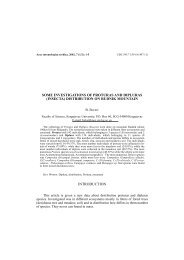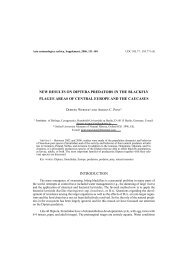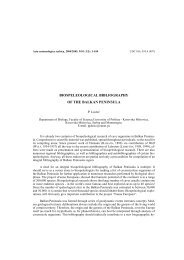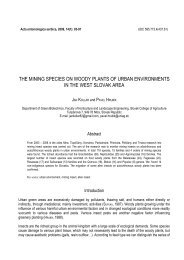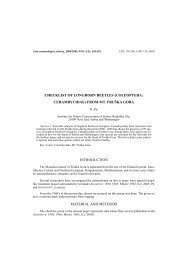Ćetković, A., Mokrousov, M., Plećaš, M., Bogusch, P., Antić, D ...
Ćetković, A., Mokrousov, M., Plećaš, M., Bogusch, P., Antić, D ...
Ćetković, A., Mokrousov, M., Plećaš, M., Bogusch, P., Antić, D ...
You also want an ePaper? Increase the reach of your titles
YUMPU automatically turns print PDFs into web optimized ePapers that Google loves.
Status of Asian Sceliphron spp. in Europe 105<br />
contributing little to the previous knowledge of the S. curvatum distribution. In the meantime, we also<br />
accumulated a number of additional records from most countries of the region, presented herewith (Slovenia,<br />
Croatia, Montenegro, Serbia, Bulgaria, Greece – see Fig. 2), but without providing the additional (missing)<br />
country records. A few of them have brought about slight changes to the established range limits (in Greece),<br />
but more importantly, some modify the recorded history of the species spreading. Of particular interest are<br />
the recoveries of the two specimens from northern Serbia (Surčin in 1995 and Kosmaj Mt. in 1996), as well<br />
as one from Greece (Athens in 1999), which shift the respective timings of their published “first arrivals”<br />
(ĆETKOVIĆ et al., 2004; SCHMID-EGGER, 2005) to two years earlier. Correspondingly, our record from central<br />
Dalmatia (Primošten in 1996), from the same year as the two earliest country records taken some 200-<br />
250 km more northwestwards (GUSENLEITNER, 1996; STRAKA et al., 2004), corroborates the fact that the<br />
species was well established along most of the Croatian northwestern coastlands at the time of these<br />
simultaneous first detections (note that one of the records became available only 8 years later, and the other<br />
one only now). Similarly, our additional record of S. curvatum from central Bulgaria (Proslav in 1997) confirms<br />
the advanced state of its establishment at the moment of the first (published) record, in the same year<br />
(JACOBS, 2005; SCHMID-EGGER, 2005).<br />
This re-assessed sequence of “first appearances” southeastwards along the possible spreading routes (cf.<br />
SCHMID-EGGER, 2005), from western Slovenia (1992) through the central Croatian coast (1996) and the<br />
southern Montenegrin coast (1998) to southern Greece (1999), and from eastern Austria (1987-1989) and<br />
northeastern Slovenia (1991), through northern Serbia (1995) to central/southern Bulgaria (1997), renders<br />
other intermediate dates less informative in revealing the dynamics of this process (e.g. the Hungarian record<br />
in 1995, westernmost Croatian record in 1996, etc.). This also emphasises the fact that the spatio-temporal<br />
pattern of discovery of a spreading species usually shows a time-lag relative to the dynamics of its real<br />
spread. Given that several important records have resulted from very accidental encounters (often by<br />
unprofessional persons), or otherwise from mainly non-systematic collecting, makes interpretations<br />
(reconstructions) of spreading dynamics relatively inaccurate. Similarly, the essential lack of S. curvatum<br />
records from Bosnia & Herzegovina, Albania, FYR Macedonia, Turkey, most of mainland Croatia and<br />
Greece, most of Romania, eastern and northern Bulgaria, southern Serbia, southern Italy, etc. are merely a<br />
consequence of a spatially uneven collecting effort (i.e. not the genuine gaps in spreading); particularly<br />
curious is that it was not yet detected in the Asiatic part of Turkey, despite the extensive available data (cf.<br />
LJUBOMIROV & YILDIRIM, 2008).<br />
The recent record of S. curvatum from Astrakhan (S Russia, 2010), apart from being easternmost in Europe,<br />
suggests that the species will probably continue to spread eastwards using both northern and southern<br />
routes around the Caspian Sea. With this most recently documented spreading, S. curvatum has reduced the<br />
distance from its nearest known natural occurrence in southwest Asia (Iraq: Baghdad) to only about 1,100 km<br />
(from Georgia/Abkhazia) and the distance from the easternmost European locality in Russia to the closest<br />
record in central Asia is about 1,700 km (Uzbekistan) – as shown in Fig. 3.<br />
Remarks on the western range limits of S. deforme and S. curvatum in Asia<br />
With the ongoing extension of the allochtonous ranges of both species eastwards, it is of interest to<br />
reconsider the knowledge of their respective westernmost and/or northernmost native distribution limits in<br />
Asia. As established above, native ranges of the two species are nearly parapatric (i.e. vicariant):<br />
S. curvatum encompasses parts of southwestern to central and southern Asia, while S. deforme inhabits<br />
large areas of central, eastern and south to southeastern Asia. On a coarse scale, and based on the<br />
available, relatively sparse records, there are two wider areas where the two species appear as possibly<br />
sympatric: parts of central Asia (Fig. 3) and northern India to Nepal (not shown).



